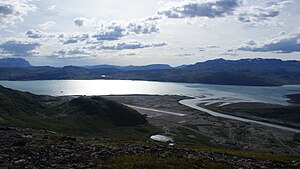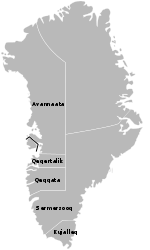Narsarsuaq: Difference between revisions
Me ne frego (talk | contribs) |
m →Climate: much better |
||
| Line 59: | Line 59: | ||
|38|33|37|42|37|52|65|70|68|51|60|61|<!--rain--> |
|38|33|37|42|37|52|65|70|68|51|60|61|<!--rain--> |
||
|accessdate = 2010-07-06 |
|accessdate = 2010-07-06 |
||
|sctemp = |
|||
}} |
}} |
||
Revision as of 18:32, 10 April 2011
Narsarsuaq | |
|---|---|
 Narsarsuaq and Tunulliarfik Fjord | |
| Federacy | Kingdom of Denmark |
| Country | |
| Municipality | Kujalleq |
| Government | |
| • Mayor | Jørgen Lund |
| Population (2010) | |
| • Total | 158 |
| Time zone | UTC-03 |
| Postal code | 3923 |
Narsarsuaq (old spelling: Narssarssuaq) is a settlement in the Kujalleq municipality in southern Greenland. It had 158 inhabitants in 2010.[2] There is a thriving tourism industry in and around Narsarsuaq, whose attractions include a great diversity of wildlife, gemstones, tours to glaciers, and an airfield museum. The name of the settlement means great plain in Greenlandic.
History

Narsarsuaq was the principal city of Greenland in the times of Erik the Red, whose Brattahlíð farm is believed to have been located west of the settlement, in Qassiarsuk across the Tunulliarfik Fjord. There are the traces of the early Norse settlement and a replica of the first Christian church on the American continent.[3]
In 1941, the United States built an air base at Narsarsuaq called Bluie West One, an important link in the North Atlantic Ferry Route. Thousands of planes used BW1 as a stepping stone on their way from the aircraft factories in North America to the battlegrounds of Europe. After the end of the war, BW1 continued to be developed, but it was rendered surplus by the advent of mid-air refueling and the construction of the larger Thule Air Base in northern Greenland. In 1951, it was agreed that Denmark and the U.S. would jointly oversee the airbase; in 1958, the U.S. abandoned it, but it was reopened the following year by the Danish government after the loss of the vessel Hans Hedtoft with all souls south off Cape Farewell.[4] The ruins of a former military hospital can still be found in the vicinity of the settlement.
Transport
Narsarsuaq Airport serves as the principal airfield in southwestern Greenland, with seasonal international flights from Iceland operated by Air Iceland and Denmark operated by Air Finland for Air Greenland, feeding the commuter flights from communities of southern Greenland operated by Air Greenland. Small planes crossing the Atlantic sometimes replicate the North Atlantic Ferry Route, stopping at Narsarsuaq Airport and other WWII airfields, including Goose Bay, Newfoundland in Canada and Reykjavík in Iceland.
Population
The population growth of the settlement is strictly tied to the traffic growth dynamics at the local airport.[5]
Climate
Narsarsuaq experiences boundary subarctic climate (Köppen: Dfc), which barely escapes being classified as polar climate, which is typical for the rest of Greenland. The summers in Narsarsuaq are the warmest of all cities in Greenland.
| Climate data for Narsarsuaq, Greenland (1961-1990) | |||||||||||||
|---|---|---|---|---|---|---|---|---|---|---|---|---|---|
| Month | Jan | Feb | Mar | Apr | May | Jun | Jul | Aug | Sep | Oct | Nov | Dec | Year |
| Mean daily maximum °C (°F) | −2.6 (27.3) |
−2.1 (28.2) |
−1.0 (30.2) |
3.7 (38.7) |
8.9 (48.0) |
12.4 (54.3) |
14.3 (57.7) |
13.2 (55.8) |
9.0 (48.2) |
3.8 (38.8) |
0.4 (32.7) |
−2.1 (28.2) |
4.8 (40.7) |
| Mean daily minimum °C (°F) | −11.1 (12.0) |
−10.5 (13.1) |
−9.5 (14.9) |
−4.4 (24.1) |
1.4 (34.5) |
4.5 (40.1) |
6.4 (43.5) |
5.5 (41.9) |
2.0 (35.6) |
−2.9 (26.8) |
−6.9 (19.6) |
−10.1 (13.8) |
−3.0 (26.7) |
| Average precipitation mm (inches) | 38 (1.5) |
33 (1.3) |
37 (1.5) |
42 (1.7) |
37 (1.5) |
52 (2.0) |
65 (2.6) |
70 (2.8) |
68 (2.7) |
51 (2.0) |
60 (2.4) |
61 (2.4) |
614 (24.4) |
| Source: Danish Meteorological Institute[6] | |||||||||||||
Arboretum Groenlandicum


On the lower slopes of the Mellemlandet ridge bounding Qooroq Fjord from the northwest, in close proximity to Narsarsuaq Airport there is a unique 'botanical garden of the Arctic', called Arboretum Groenlandicum. [7]
It encompasses 15 hectares and sheltering 110 plant species, mostly varieties of boreal taiga trees, such as Siberian larch, Lodgepole Pine, White Spruce, or Sitka Spruce,[8] and various bushes. Many individual trees are tagged or otherwise marked.
References
- ^ Kujalleq Municipality Template:Da icon
- ^ Statistics Greenland Template:Da icon
- ^ archaeology.org
- ^ warbirdforum.com
- ^ a b Statistics Greenland
- ^ Danish Meteorological Institute Template:Da icon
- ^ Københavns Universitiet
- ^ Arboretum Groenlandicum documentation, Narsarsuaq


